
Fable is a literary genre: a succinct fictional story, in prose or verse, that features animals, legendary creatures, plants, inanimate objects, or forces of nature that are anthropomorphized, and that illustrates or leads to a particular moral lesson, which may at the end be added explicitly as a concise maxim or saying.

Aesop's Fables, or the Aesopica, is a collection of fables credited to Aesop, a slave and storyteller believed to have lived in ancient Greece between 620 and 564 BCE. Of diverse origins, the stories associated with his name have descended to modern times through a number of sources and continue to be reinterpreted in different verbal registers and in popular as well as artistic media.

The Devil's Dictionary is a satirical dictionary written by American journalist Ambrose Bierce, consisting of common words followed by humorous and satirical definitions. The lexicon was written over three decades as a series of installments for magazines and newspapers. Bierce's witty definitions were imitated and plagiarized for years before he gathered them into books, first as The Cynic's Word Book in 1906 and then in a more complete version as The Devil's Dictionary in 1911.

Flash fiction is a fictional work of extreme brevity that still offers character and plot development. Identified varieties, many of them defined by word count, include the six-word story; the 280-character story ; the "dribble" ; the "drabble" ; "sudden fiction" ; "flash fiction" ; and "microstory".

George Sterling was an American writer based in the San Francisco, California Bay Area and Carmel-by-the-Sea. He was considered a prominent poet and playwright and proponent of Bohemianism during the first quarter of the twentieth century. His work was admired by writers as diverse as Ambrose Bierce, Robinson Jeffers, Jack London, Upton Sinclair, Theodore Dreiser, and Sinclair Lewis.

Jean-Thomas "Tomi" Ungerer was an Alsatian artist and writer. He published over 140 books ranging from children's books to adult works and from the fantastic to the autobiographical. He was known for sharp social satire and witty aphorisms. Ungerer is also famous as a cartoonist and designer of political posters and film posters.

"An Occurrence at Owl Creek Bridge" (1890) is a short story by the American writer and Civil War veteran Ambrose Bierce. Described as "one of the most famous and frequently anthologized stories in American literature", it was originally published by The San Francisco Examiner on July 13, 1890, and was first collected in Bierce's book Tales of Soldiers and Civilians (1891). The story, which is set during the American Civil War, is known for its irregular time sequence and twist ending. Bierce's abandonment of strict linear narration in favor of the internal mind of the protagonist is an early example of the stream of consciousness narrative mode.

William March was an American writer of psychological fiction and a highly decorated U.S. Marine. The author of six novels and four short-story collections, March was praised by critics but never attained great popularity.
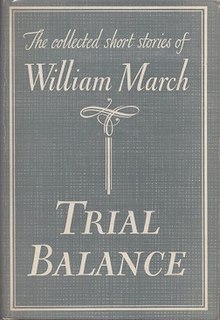
Trial Balance: The Collected Short Stories of William March is a collection of short stories by American author William March, first published in 1945 by Harcourt, Brace and Company. The 55 stories span almost the entirety of March's entire career until then, from 1929 to 1945.
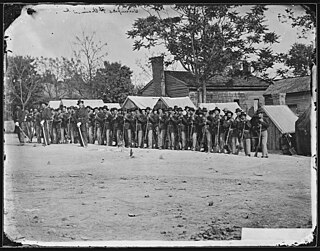
The 9th Indiana Volunteer Infantry Regiment was a volunteer infantry regiment in the Union Army during the American Civil War. It was organized on April 22, 1861, for three-months' service in Indianapolis. After being reorganized for three years' service in late August and early September 1861, the 9th took part in many major battles, including Shiloh, Stones River, Chickamauga, Lookout Mountain, Missionary Ridge, Kennesaw Mountain and the Siege of Atlanta.
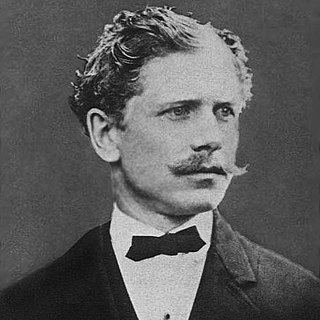
Ambrose Gwinnett Bierce was an American short story writer, journalist, poet, and American Civil War veteran. His book The Devil's Dictionary was named as one of "The 100 Greatest Masterpieces of American Literature" by the American Revolution Bicentennial Administration. His story "An Occurrence at Owl Creek Bridge" has been described as "one of the most famous and frequently anthologized stories in American literature", and his book Tales of Soldiers and Civilians was named by the Grolier Club as one of the 100 most influential American books printed before 1900.

James F. Bowman was a journalist and poet in Northern California, and a co-founder of the Bohemian Club. Bowman served on several newspapers in Placerville, Sacramento and San Francisco during a 24-year career. Through his contacts among San Francisco journalists, Bowman befriended Mark Twain, artist William Keith, critic Ambrose Bierce and a great many others.
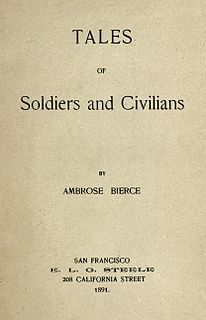
Tales of Soldiers and Civilians is a collection of short stories by American Civil War soldier, wit, and writer Ambrose Bierce, also published under the title In the Midst of Life. With a stated publication date of 1891 the stories describe unusual incidents in the lives of soldiers and civilians during the American Civil War. Tales of Soldiers and Civilians was named by the Grolier Club as one of the 100 most influential American books printed before 1900, stating "These short stories are among the finest, and best known, in American literature. ... Written in a clear simple style, with each phrase contributing to the total effect, Bierce's tales pointed the way for the American short-story writer." Bierce's famous story "An Occurrence at Owl Creek Bridge" is included in this collection.
The Lion, the Bear and the Fox is one of Aesop's Fables that is numbered 147 in the Perry Index. There are similar story types of both eastern and western origin in which two disputants lose the object of their dispute to a third.
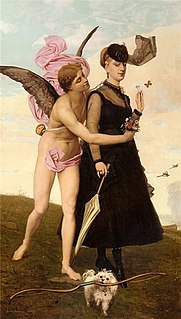
The Young Widow is a fable of Italian origin, made famous by being included in La Fontaine's Fables (VI.21). Originally a cynical attack on female inconstancy, later treatments were more thoughtful.
Bertha Clark Pope Damon (1881–1975) was an American humorist, author, lecturer, and editor. She wrote the best-selling humorous memoir Grandma Called It Carnal.
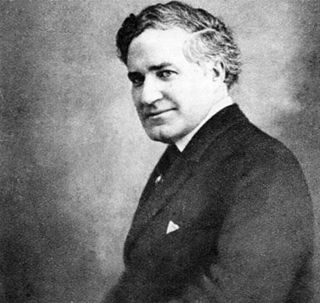
Herman George Scheffauer was a German-American poet, architect, writer, dramatist, journalist, and translator.
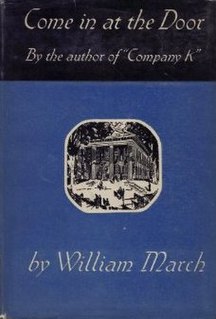
Come in at the Door is the first book in Alabama author William March’s “Pearl County” collection of novels and short fiction. It is an example of the Southern Gothic genre. Following the success of March's first novel, Company K, about World War I, the author began to explore his own childhood in south Alabama in his fiction. Come in at the Door is set in the three towns of Hodgetown, Reedyville, and Baycity, the latter offering a fictionalized vision of Mobile, Alabama. The book was first published in 1934 by Smith & Haas in New York and republished by the University of Alabama Press in 2015. The other novels in the series are The Tallons and The Looking-Glass.
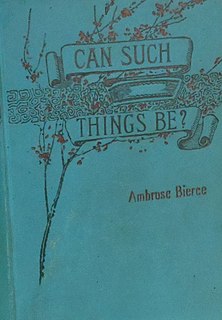
"The Death of Halpin Frayser" is a Gothic ghost story by Ambrose Bierce. It was first published in the San Francisco periodical The Wave on December 19, 1891 before appearing in the 1893 collection Can Such Things Be?

"A Psychological Shipwreck" is a short story by American Civil War soldier, wit, and writer Ambrose Bierce and published by The Argonaut under the title "My Shipwreck" on May 24, 1879. It was included in the 1893 collection Can Such Things Be?


















